How to Make Homemade Italian Sausage: A Step-by-Step Guide

Italian sausage is one of my favorite pork products, because it can be used in so many delicious applications from pasta sauce to meatballs, used as a pizza topping, added to stuffing or in stuffed peppers. The list can go on and on!
There are some pretty tasty options at the grocery store for Italian sausage, and I typically grab a package while shopping to keep on hand, but this time I set out on a journey to make my own from scratch. I’m talking about bulk Italian sausage here, and not the links. To make links, you need sausage casing and a tool called a sausage stuffer, so to keep this adventure of mine more approachable, I made the sausage without stuffing it into casings, which I think keeps it more versatile anyways.
The first step to making Italian sausage is to make sure you have the proper tools. Because you’ll be grinding your own meat, you’ll need a meat grinder (see all the KitchenAid meat grinder parts pictured below), or you can use a food processor to “grind” the meat. The texture will be a bit different, but it will still be delicious.
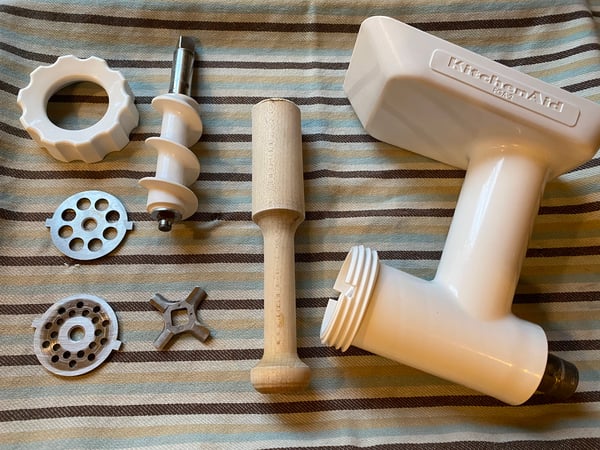 Italian sausage doesn’t require too many ingredients, but each and every ingredient plays a key role in the final outcome. Here’s the breakdown:
Italian sausage doesn’t require too many ingredients, but each and every ingredient plays a key role in the final outcome. Here’s the breakdown:
Boneless Pork Butt: This muscle comes from the shoulder and should be used for sausage making due to its ideal lean-to-fat ratio, which is about 70%-30%. It’s this fat that adds that juiciness to the sausage and prevents it from drying out when cooked. The extra fat also adds a bunch of flavor! Side note: You can use pre-ground pork to streamline, but that only contains about 20% fat and that extra 10% from the butt makes a really significant difference.
Spices and flavorings: I keep the seasoning for my sausage traditional by using a combination of crushed fennel seeds, sweet paprika, red pepper flakes, ground coriander, garlic, salt and pepper. This produces a “sweet” variety of sausage because of the addition of fennel seeds. You can use a mortar and pestle to lightly crush the fennel seeds, or simply rough chop them with your chef’s knife.
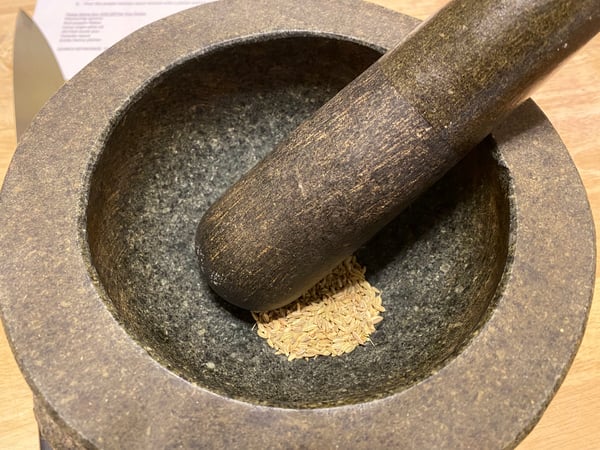
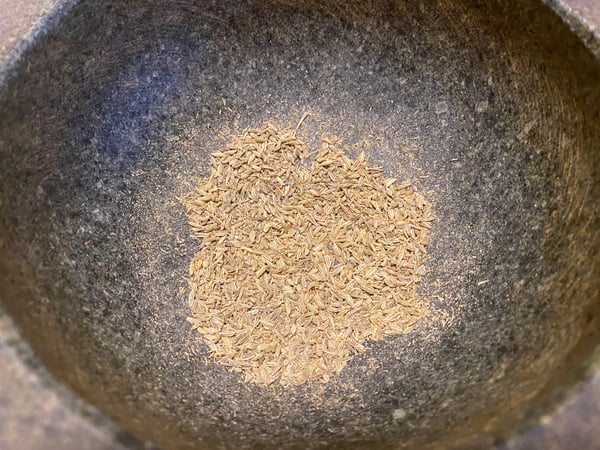 According to On Food and Cooking by Harold McGee, “fennel is not only distinctively aromatic, but also intensely sweet - 13 times sweeter than table sugar, weight for weight.” So, it’s that addition of the fennel that makes sweet Italian sausage sweet. To make spicy Italian sausage, reduce the amount of fennel and increase the red chili flakes.
According to On Food and Cooking by Harold McGee, “fennel is not only distinctively aromatic, but also intensely sweet - 13 times sweeter than table sugar, weight for weight.” So, it’s that addition of the fennel that makes sweet Italian sausage sweet. To make spicy Italian sausage, reduce the amount of fennel and increase the red chili flakes.
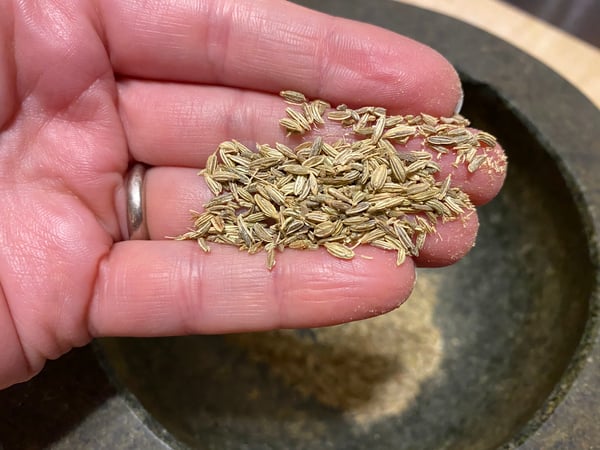 The most important part of making sausage, if you’re grinding your own meat, is to make sure the meat is as cold as possible. You want to keep the fat in solid pieces throughout the sausage for a better texture, and if your meat is not cold enough, the fat will shmear when it goes through the grinder compromising the texture.
The most important part of making sausage, if you’re grinding your own meat, is to make sure the meat is as cold as possible. You want to keep the fat in solid pieces throughout the sausage for a better texture, and if your meat is not cold enough, the fat will shmear when it goes through the grinder compromising the texture.
There are three steps to accomplishing this:
1. Cut your pork butt into long strips, place them on a sheet tray and set that tray in the freezer for about 30 minutes. This will firm up the fat ensuring it does not shmear.
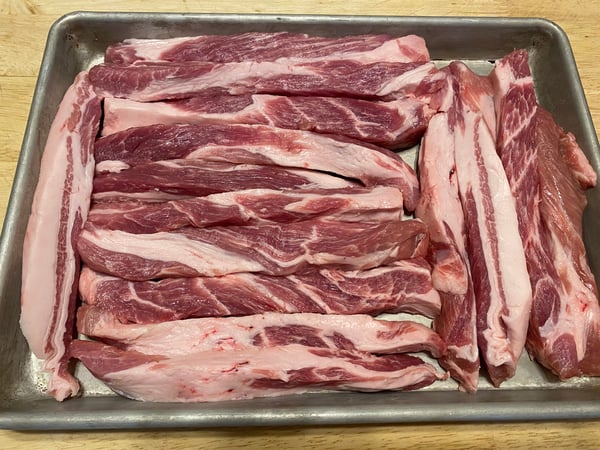 2. Grind your very cold strips of pork through the largest plate (biggest holes) first to initially break down the meat. Then you’ll pass the coarsely ground meat through the smallest plate (smallest holes) for that classic ground meat texture. If you think your meat is getting too warm at any point throughout the process, place it in the fridge for about 10 minutes.
2. Grind your very cold strips of pork through the largest plate (biggest holes) first to initially break down the meat. Then you’ll pass the coarsely ground meat through the smallest plate (smallest holes) for that classic ground meat texture. If you think your meat is getting too warm at any point throughout the process, place it in the fridge for about 10 minutes.
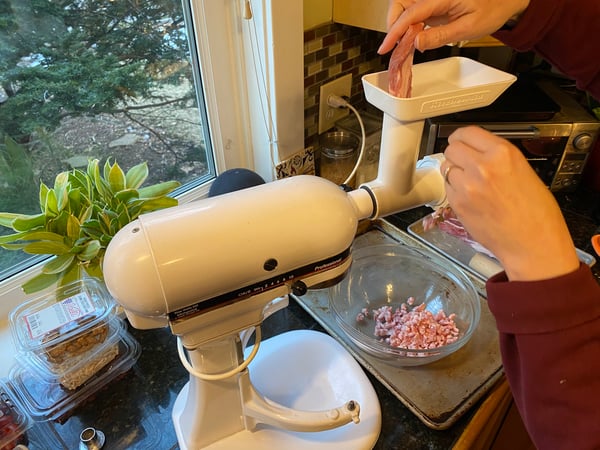
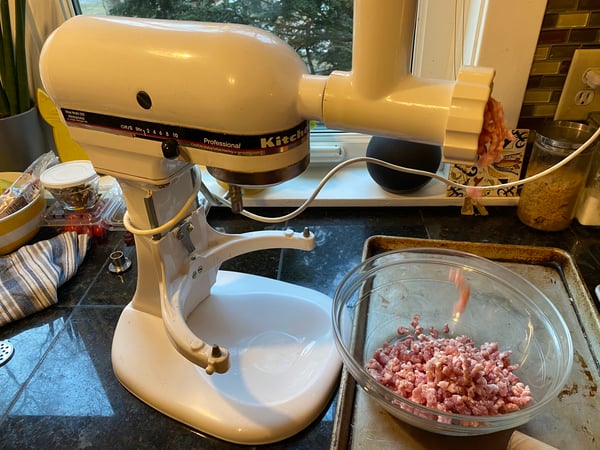
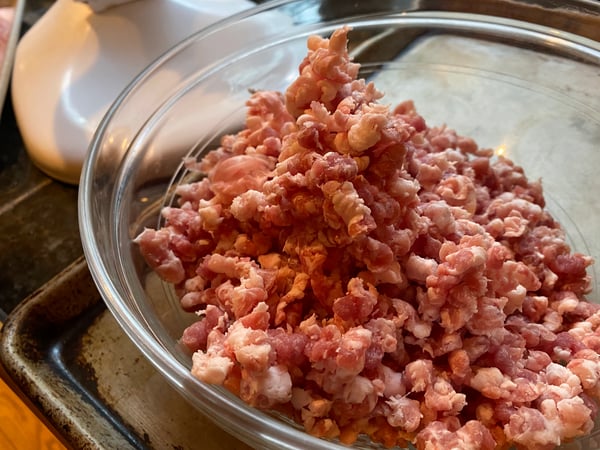 Meat after first pass through grinder
Meat after first pass through grinder
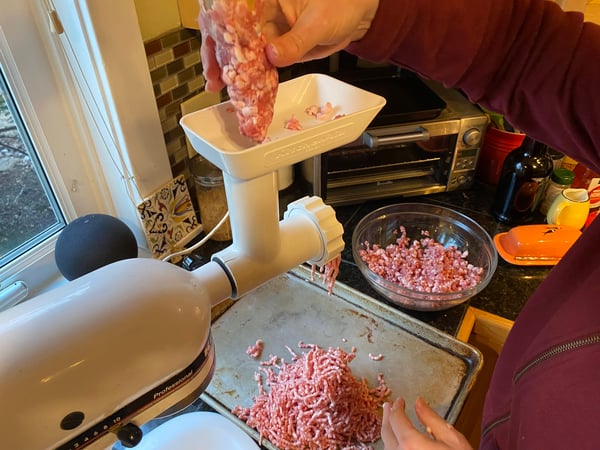
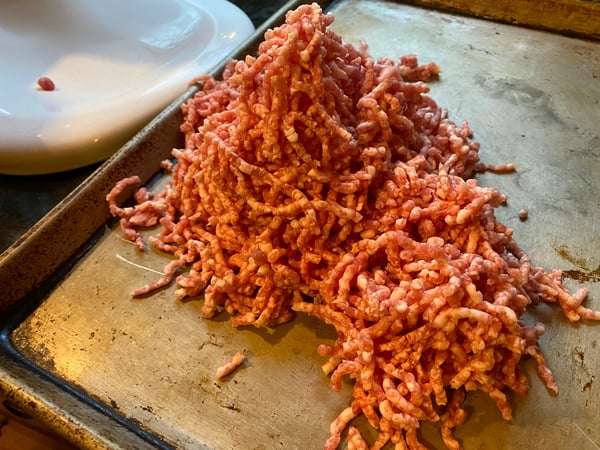
Meat after second pass through grinder
3. To make sure all of the meat has passed through the grinder, do what the pros do. Take a piece of plastic wrap and thread it through the grinder. This will push any remaining meat through the plate without shredding the plastic. It’s a tried-and-true trick!
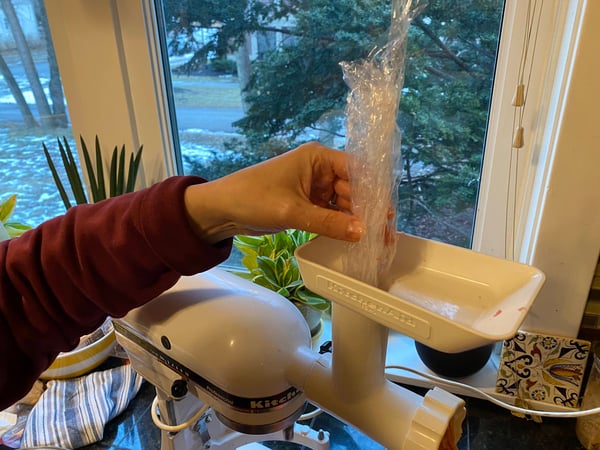 Now that you have your ground pork mixture, place it in the fridge to keep it cold. Spend the next few minutes cleaning your meat grinder parts because if you don’t, it will be harder to clean the longer it sits. Luckily all of the parts I used can go in the dishwasher after an initial cleaning to remove any pieces of pork.
Now that you have your ground pork mixture, place it in the fridge to keep it cold. Spend the next few minutes cleaning your meat grinder parts because if you don’t, it will be harder to clean the longer it sits. Luckily all of the parts I used can go in the dishwasher after an initial cleaning to remove any pieces of pork.
All that’s left is to mix in the spices and seasonings. To accomplish this step, use a spatula and not your hands to gently mix in the seasoning for easy cleanup and to keep the mixture cold.
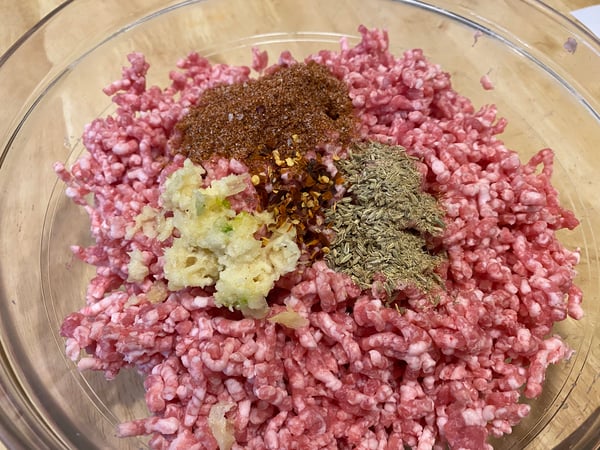 You now have homemade, bulk Italian sausage! This recipe makes a nice quantity, so you can use half now and place the other half in the freezer for later use.
You now have homemade, bulk Italian sausage! This recipe makes a nice quantity, so you can use half now and place the other half in the freezer for later use.
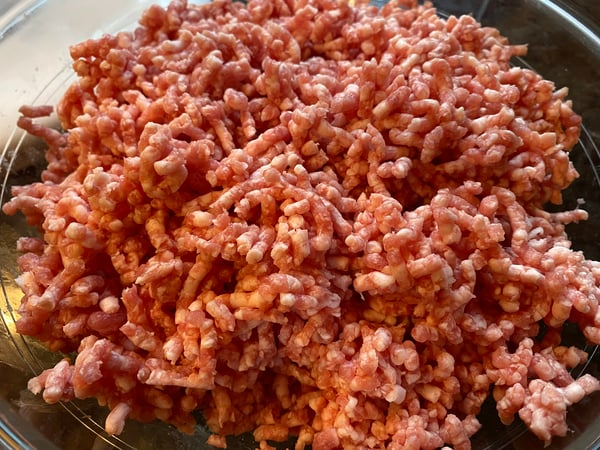
Homemade Italian Sausage
Scroll down for a printable version of this recipe
Yield: 2 pounds
Active time: 1 hour
Start to finish: 1 hour
2 pounds boneless pork butt
3 teaspoons kosher salt
1 teaspoon black pepper
2 teaspoons fennel seeds, coarsely crushed
2 teaspoons sweet paprika
1/2 to 1 teaspoon red pepper flakes (optional)
1/2 teaspoon ground coriander
4 cloves garlic, finely minced
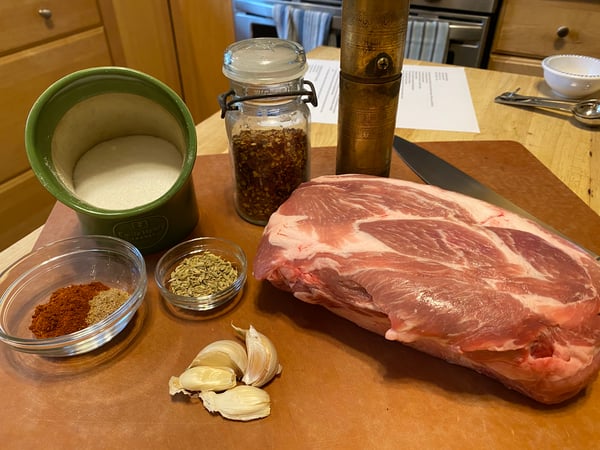
- Cut the pork butt into long strips and place them on a sheet tray. Set in the freezer for 30 minutes to chill the fat.
- While the pork is chilling, set up your meat grinder with the largest plate (biggest holes), and place a bowl under the grinder to catch the meat.
- If using a stand mixer attachment, set it on the highest speed, and feed each strip of cold pork through the grinder, using the plunger to help push the meat through. When done, feed a piece of plastic wrap through the grinder to ensure all of the pork has been pushed through.
- Place the bowl of coarsely ground pork in the refrigerator.
- While the pork is chilling, remove the plastic wrap and change the plate to the one with the smallest holes. Tip: Save this piece of plastic as you’ll use it one more time.
- Place another bowl or sheet tray under the grinder to catch the meat, and pass the coarsely ground pork through the small plate. Feed the piece of plastic through the grinder one more time.
- Using a spatula, mix in the salt, pepper, crushed fennel seeds, paprika, pepper flakes, coriander and garlic until thoroughly mixed.
- Use the sausage in pasta sauces, meatballs, as a pizza topping, in stiffed peppers, or any other place you would use Italian sausage.
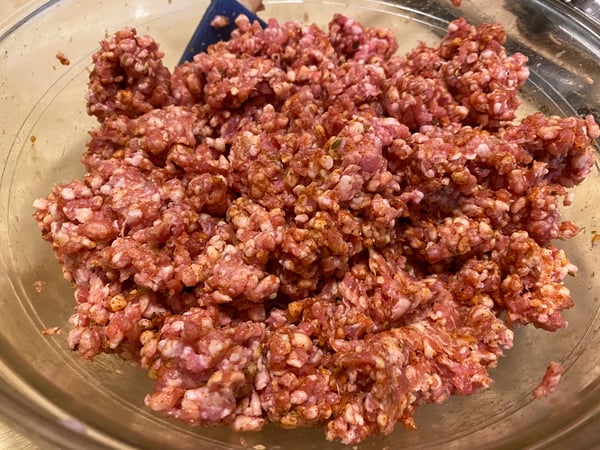 I used half of ours to make a pasta “pie” with an Italian sausage crust. I know… it sounds crazy and amazing at the same time!
I used half of ours to make a pasta “pie” with an Italian sausage crust. I know… it sounds crazy and amazing at the same time!
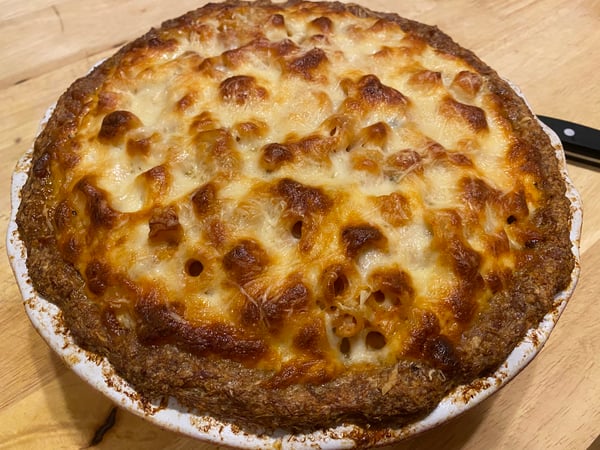 I lined the bottom and sides of a pie dish with about 1/4-inch layer of the sausage, and then filled it with cooked noodles (I used short noodles but you can use long if you prefer), tossed with tomato sauce and grated mozzarella and parmesan cheeses.
I lined the bottom and sides of a pie dish with about 1/4-inch layer of the sausage, and then filled it with cooked noodles (I used short noodles but you can use long if you prefer), tossed with tomato sauce and grated mozzarella and parmesan cheeses.
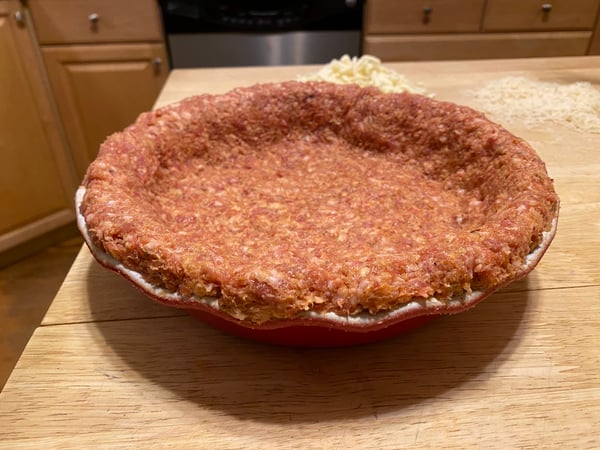

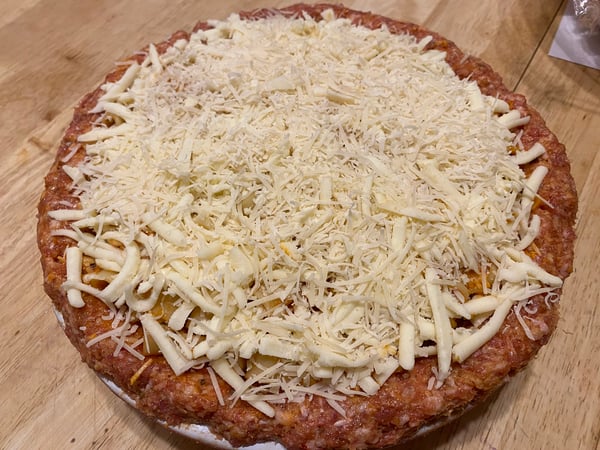 I topped the “pie” with more cheese, and baked it at 375° on a parchment-lined sheet tray until the top was golden brown and bubbly, about 40 minutes. Let the pasta “pie” rest for about 10 minutes, cut wedges and enjoy!
I topped the “pie” with more cheese, and baked it at 375° on a parchment-lined sheet tray until the top was golden brown and bubbly, about 40 minutes. Let the pasta “pie” rest for about 10 minutes, cut wedges and enjoy!
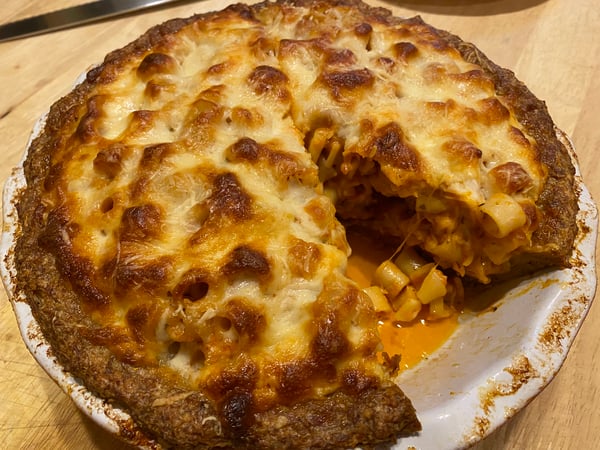 Are you looking for other creative ways to use pork or learn different cooking techniques to widen your culinary education? Then you don’t want to miss our Virtual Building Block: Pork Cookery course on Saturday, January 22nd from 10am-12pm. This class includes roughly 90 minutes of cooking and 30 minutes of lecture throughout the course, and is designed to teach you the fundamentals of how to confidently make better decisions in the kitchen, cook delicious meals by opening your taste buds, and explore the basic science behind cooking. The skills covered in class will not only be very applicable to how you cook, but also stretch your knowledge in the kitchen and broaden your palate. Our chef will be right there with you the entire class, and answer any questions you have in real time, so don’t miss this opportunity!
Are you looking for other creative ways to use pork or learn different cooking techniques to widen your culinary education? Then you don’t want to miss our Virtual Building Block: Pork Cookery course on Saturday, January 22nd from 10am-12pm. This class includes roughly 90 minutes of cooking and 30 minutes of lecture throughout the course, and is designed to teach you the fundamentals of how to confidently make better decisions in the kitchen, cook delicious meals by opening your taste buds, and explore the basic science behind cooking. The skills covered in class will not only be very applicable to how you cook, but also stretch your knowledge in the kitchen and broaden your palate. Our chef will be right there with you the entire class, and answer any questions you have in real time, so don’t miss this opportunity!
Pork is the challenge for this week's private Facebook group. Join now, make a pork dish and share it with other home cooks!
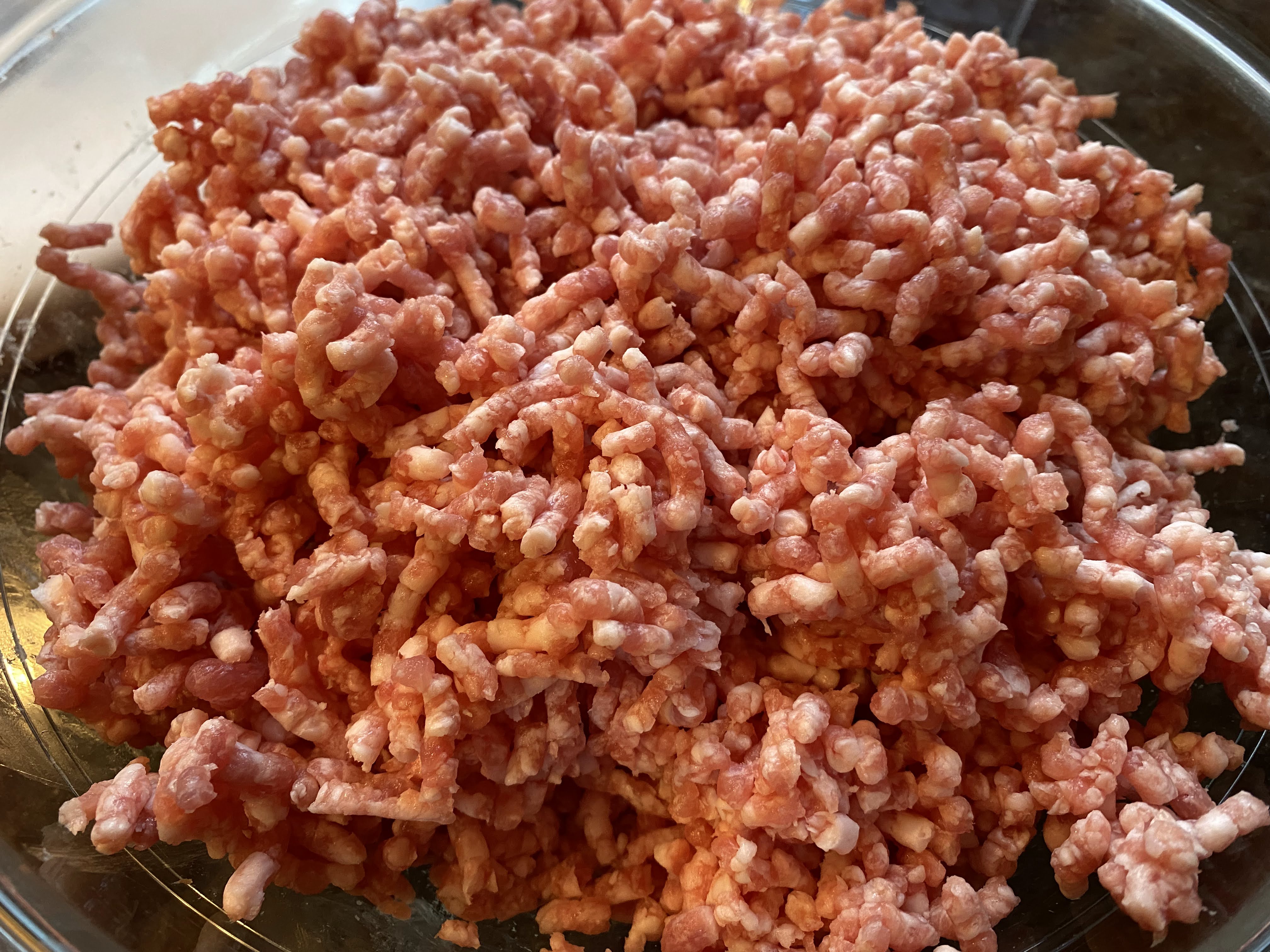
Homemade Italian Sausage
Ingredients
- 2 pounds boneless pork butt
- 3 teaspoons kosher salt
- 1 teaspoon black pepper
- 2 teaspoons fennel seeds, coarsely crushed
- 2 teaspoons sweet paprika
- 1/2 to 1 teaspoon red pepper flakes (optional)
- 1/2 teaspoon ground coriander
- 4 cloves garlic, finely minced
Instructions
- Cut the pork butt into long strips and place them on a sheet tray. Set in the freezer for 30 minutes to chill the fat.
- While the pork is chilling, set up your meat grinder with the largest plate (biggest holes), and place a bowl under the grinder to catch the meat.
- If using a stand mixer attachment, set it on the highest speed, and feed each strip of cold pork through the grinder, using the plunger to help push the meat through. When done, feed a piece of plastic wrap through the grinder to ensure all of the pork has been pushed through.
- Place the bowl of coarsely ground pork in the refrigerator.
- While the pork is chilling, remove the plastic wrap and change the plate to the one with the smallest holes. Tip: Save this piece of plastic as you’ll use it one more time.
- Place another bowl or sheet tray under the grinder to catch the meat, and pass the coarsely ground pork through the small plate. Feed the piece of plastic through the grinder one more time.
- Using a spatula, mix in the salt, pepper, crushed fennel seeds, paprika, pepper flakes, coriander and garlic until thoroughly mixed.
- Use the sausage in pasta sauces, meatballs, as a pizza topping, in stiffed peppers, or any other place you would use Italian sausage.



